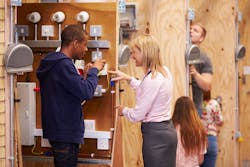$1.6 Billion Invested in Construction Workforce Education to Upskill 1.3 Million
Associated Builders and Contractors (ABC) member contractors invested $1.6 billion to provide more than 1.3 million course attendees with craft, leadership, and safety education in 2021, according to its 2022 Workforce Development Survey, up from $1.3 billion in 2020. The annual assessment quantifies the scope of ABC members’ workforce development initiatives to advance their employees’ careers in commercial and industrial construction.
Safety education accounted for the greatest share — 56% — of total workforce investment. Craft education investment increased significantly to 34% of the total in 2021, up from 22% in 2020, responding to the need for an estimated 650,000 additional construction workers in 2022. General and construction management contractors boosted their share of the total workforce development investment to 65% in 2021 from 58% in 2020.
“ABC member contractors are building the people who build America by investing billions to cultivate their long-term skill sets, creating a brighter future for their workers and their families,” said Greg Sizemore, ABC’s vice president of health, safety, environment and workforce development. “ABC member contractors are investing in flexible, competency-based, and market-driven education methodologies to build a construction workforce that is safe, skilled, and productive. Continually upskilling our people, our most valuable asset, means the merit shop construction industry is ready to realize the economic gains of the $1.2 trillion 2021 Infrastructure Investment and Jobs Act.”
Every $1 billion in extra construction spending generates an average of at least 3,900 new jobs.
Key findings from the survey include:
- ABC member contractors invested an average of 7.4% of payroll on workforce education, or $112,412.
- Women in management/supervisory roles ticked up to 19% in 2021 from 17% in 2020, and women in craft/trade roles increased from 14% to 15%.
- ABC members educate almost four times as many trade/craft personnel than the next highest positions, field managers/superintendents.
- ABC members invested in safety education for 51 employees, on average.
- More than half of respondents (61%) reported a labor shortage of severe or very severe, citing an exodus of baby boomers as the top contributor.
ABC’s all-of-the-above approach to workforce development has produced a network of ABC chapters and affiliates across the country that offer more than 800 apprenticeship, craft, safety, and management education programs — including more than 300 government-registered apprenticeship programs across 20 different occupations.
Industry consulting firm FMI conducted the 2022 Workforce Development Survey from Jan. 4 to Feb. 18, 2022. Aggregated data was derived by calculating the average amount spent on education by each respondent and multiplying that by the total number of ABC contractor members.
